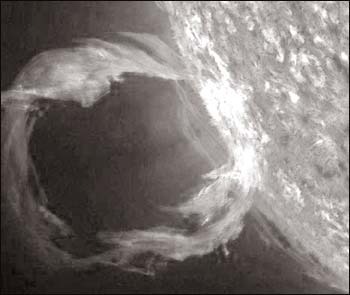NASA plans to reach the Sun
Chamari Senanayake
Human curiosity has led us to reach space, moon and now through the
latest technology, we are reaching Mars. But the ‘big guy’ of our solar
system, the almighty sun has always been ‘off limits’. Let alone
reaching the Sun, it is impossible to send something even near it. But
the brilliant scientists at NASA are now considering firing a space
probe directly at the Sun to answer some of the most important questions
about our solar system.
 A
small car-sized spacecraft will plunge into the sun’s atmosphere
approximately four million miles from its surface, exploring a region no
other spacecraft has ever visited before. The unprecedented project,
named ‘Solar Probe Plus’, is scheduled to launch by 2018. A
small car-sized spacecraft will plunge into the sun’s atmosphere
approximately four million miles from its surface, exploring a region no
other spacecraft has ever visited before. The unprecedented project,
named ‘Solar Probe Plus’, is scheduled to launch by 2018.
NASA has ventured into five science investigations that will unlock
the Sun’s biggest mysteries as the probe repeatedly passes through its
atmosphere.
‘This project allows humanity’s ingenuity to go where no spacecraft
has ever gone before,’ said Lika Guhathakurta, Solar Probe Plus program
scientist at NASA Headquarters, Washington.
‘For the very first time, we’ll be able to touch, taste and smell our
sun.’ The mission is also designed to solve two key questions of solar
physics, why is the sun’s outer atmosphere so much hotter than the sun’s
visible surface and what propels the solar wind that affects Earth and
our solar system? Due to Sun’s unimaginable heat, the spacecraft is to
be fitted with a new invention at least to minimize the heat affects as
long as possible. As the spacecraft approaches the sun, its
revolutionary carbon-composite heat shield must withstand temperatures
exceeding about 1,400 degrees Celsius (2,550 degrees Fahrenheit) and
blasts of intense radiation.
The spacecraft will have an up-close and personal view of the Sun,
enabling scientists to better understand and forecast the radiation
environment for future space explorers.
NASA invited researchers in 2009 to submit science proposals. Out of
the overwhelming response, thirteen were reviewed by a panel consisting
of NASA and independent scientists, and the five selected investigations
are receiving approximately $180 million for preliminary analysis,
design, development and tests. A telescope on the spacecraft will make
3-D images of the sun’s corona, or atmosphere. The experiment actually
will see the solar wind and provide 3-D images of clouds and shocks as
they approach and pass the spacecraft.
Another will make direct measurements of electric and magnetic
fields, radio emissions, and shock waves that course through the sun’s
atmospheric plasma. The day we would be able to understand at least some
of the mysteries of the Sun, it would be another giant step for the
mankind. |



